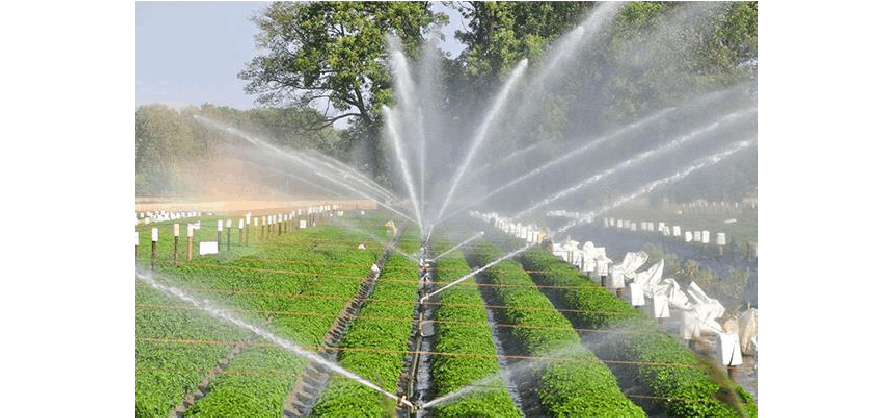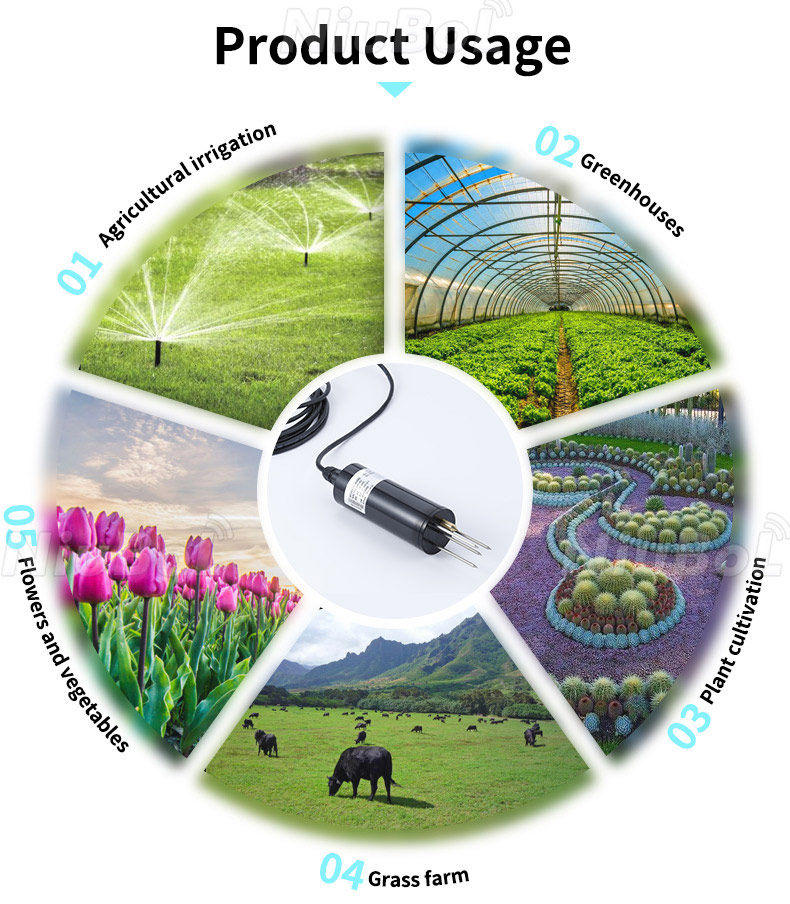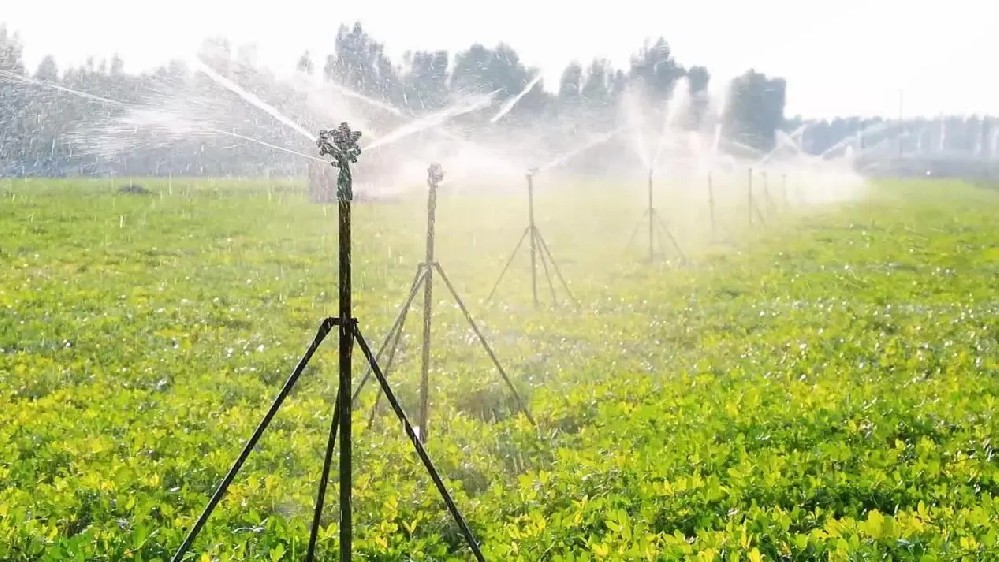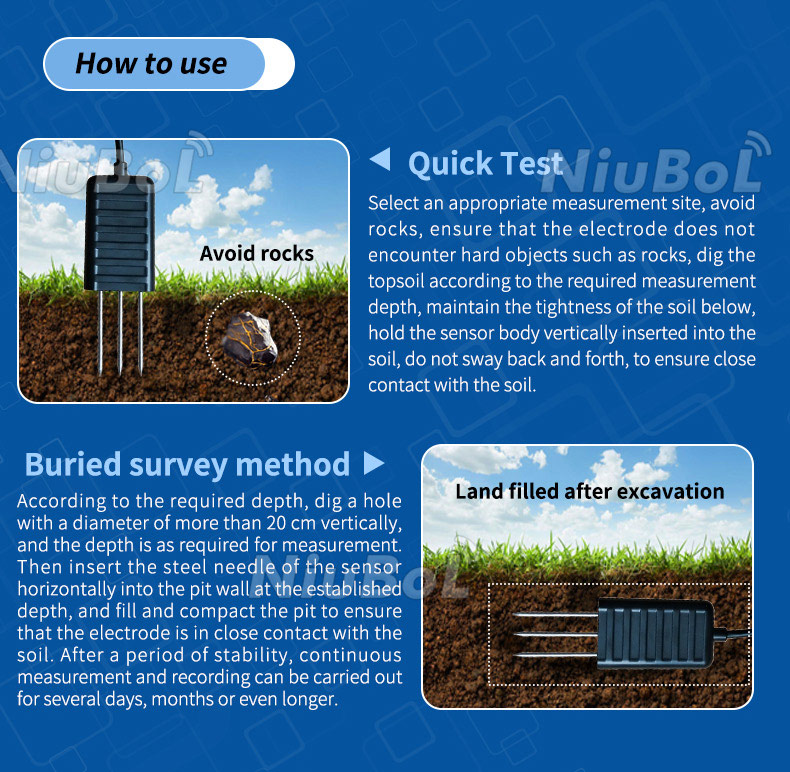

— Blogs —
—Products—
 Consumer hotline +8618073152920
Consumer hotline +8618073152920 WhatsApp:+8615367865107
Address:Room 102, District D, Houhu Industrial Park, Yuelu District, Changsha City, Hunan Province, China
Product knowledge
Time:2024-10-01 17:34:58 Popularity:2277

In modern agriculture, precision irrigation has become a key technology for improving crop yields and saving water. The core of all this is the soil moisture sensor. In this paper, we will introduce in detail the working principle and role of soil moisture sensor, as well as its application in the intelligent irrigation system, to explore why the irrigation system needs soil moisture sensor, and the great value it brings.
Soil moisture sensor is a precision device that can monitor soil moisture content in real time. It determines soil moisture by measuring the soil's dielectric constant, resistance, capacitance and other physical parameters. Common operating principles include frequency domain reflectance principle (FDR), time domain reflectance principle (TDR), resistance method of measurement and capacitance method of measurement.
Frequency Domain Reflection (FDR): The dielectric constant of the soil is determined by measuring the frequency of electromagnetic waves propagating through the soil, thus calculating the moisture content of the soil.
Time Domain Reflection Principle (TDR): Measurement of the dielectric constant of the soil by utilizing the reflection time of the electromagnetic pulse in the soil, thus obtaining the humidity of the soil.
Resistance method measurement: The moisture content of the soil is determined by measuring the resistance of the moisture in the soil; the higher the moisture content, the lower the resistance.
Capacitance method of measurement: Measurement of soil moisture based on the characteristics of the soil's capacitance value as a function of humidity, usually using a moisture-sensitive capacitor as the sensor's sensitive element.
These principles make the soil moisture sensor can accurately sense the moisture content in the soil, providing key data support for agricultural production.
Soil moisture sensor plays a vital role in agricultural production. It can monitor soil moisture in real time, providing farmers with a scientific basis for irrigation, to avoid excessive irrigation and drought damage to crops. By accurately controlling the amount and frequency of irrigation water, soil moisture sensors help to increase crop yields and reduce water waste.
Irrigation systems need soil moisture sensors because they can provide accurate soil moisture data to inform irrigation decisions. By monitoring soil moisture in real time, farmers can precisely control the amount and frequency of irrigation to avoid crop damage caused by over-irrigation and drought. This not only improves crop yields, but also reduces water waste.
1. Significant water saving effect: Through precise irrigation, soil moisture sensors can significantly reduce the waste of water resources. According to statistics, compared with traditional irrigation methods, the water utilization rate of farms using intelligent irrigation systems can be increased by about 30%.
2. Improve crop yield and quality: reasonable soil moisture helps crop growth and development. Soil moisture sensors can help farmers provide the best growing environment for crops, thus improving crop yield and quality.
3. Reduce production costs: Smart irrigation systems can reduce labor and time costs. Through automation and intelligent management, farmers can manage their farmland more efficiently and improve productivity.
4. Protecting the ecological environment: Precision irrigation helps to reduce the amount of water draining from farmland, thus reducing pollution to the environment. At the same time, by reducing the use of fertilizers and pesticides, soil moisture sensors also help protect the agro-ecological environment.
In addition, soil moisture sensors are able to combine with other agricultural sensors to achieve integrated water and fertilizer management. Through precise fertilization and irrigation, farmers can reduce the use of pesticides and chemical fertilizers and mitigate environmental pollution. At the same time, the intelligent irrigation system can also reduce the labor intensity of farmers and improve the efficiency of agricultural production.
From a value perspective, the application of soil moisture sensors in smart irrigation systems brings significant economic and social benefits. It improves crop yield and water utilization efficiency, and reduces production costs and environmental pollution. At the same time, the intelligent irrigation system can also promote the intelligent and sustainable development of agriculture and provide strong support for the transformation and upgrading of modern agriculture.
The smart irrigation system realizes real-time monitoring of soil moisture and automatic adjustment of irrigation by integrating soil moisture sensors. This process involves several key steps:
1. Data Acquisition: Soil moisture sensors are buried in the active layer of the crop root system to continuously monitor the moisture content of the soil. These sensors utilize techniques such as electrical resistance changes, dielectric constant measurements, etc. to convert soil moisture into an electrical signal.
2. Signal Processing: The collected electrical signals are transmitted to a control center, usually a Programmable Logic Controller (PLC) or a smart irrigation controller. Here, the signals are A/D converted into digital data for easy system processing.
3. Intelligent Decision Making: The system is pre-set with an ideal range of soil moisture, e.g. 50% to 60% RH. When the actual moisture is below the set lower limit, the system determines that irrigation is needed; if it is higher than the upper limit, it is assumed that no irrigation is needed. This decision-making process may be combined with machine learning algorithms to optimize the irrigation strategy.
4. Automatic control: Once the decision is made that irrigation is needed, the system automatically activates the irrigation equipment, such as adjusting the speed of the water pump through an inverter to control the irrigation flow rate and ensure that the right amount of water is delivered to the field. Solenoid valves control the opening and closing of the water flow to ensure precise irrigation.
5. Feedback loop: During the irrigation process, the system continuously monitors soil moisture to ensure that it is not over-irrigated. When the soil moisture reaches the ideal range, the system automatically stops irrigation, forming a closed-loop control system.
6. Remote management: Modern smart irrigation systems are often equipped with cloud management platforms that support remote monitoring and adjustment of irrigation parameters via the Internet, allowing managers to make decisions based on real-time data anytime, anywhere.
7. Environmental adaptability: The system can also take into account other environmental factors, such as weather forecasts, to avoid irrigating when rainfall is expected, further optimizing water use.
By automating the process in this way, smart irrigation systems not only save water and reduce manpower requirements, but also improve irrigation efficiency and the quality of crop growth, making them an important part of modern agricultural technology.

Intelligent irrigation system is a highly integrated scientific and technological system designed to improve water utilization efficiency and crop growth conditions through precise control of irrigation. Its main components include:
1. Sensors: including soil moisture sensors, soil temperature sensors, meteorological sensors (e.g., measuring wind speed, humidity, temperature), etc., which are used for real-time monitoring of soil and environmental conditions.
2. Control center: as the “brain” of the system, processing sensor data, according to preset parameters or intelligent algorithms to decide whether to irrigate, as well as the amount and time of irrigation. 3. actuators: such as solenoid valves and other devices.
3. Actuators: such as solenoid valves, spray nozzles, etc., directly control the opening and closing of the irrigation equipment, to ensure that the irrigation task in accordance with the instructions of the control center.
4. Communication module: support wireless or wired communication, ensure data transmission between sensor and control center, control center and remote management platform, realize remote monitoring and control.

5. cloud management platform: provide data analysis, storage, remote control interface, managers can check the irrigation status in real time and adjust the irrigation strategy through mobile application or computer.
6. water source system: including water supply facilities, such as water pumps, water towers, pipeline networks, etc., to ensure the supply of irrigation water.
7. power and power supply system: provide the necessary power for the electronic devices in the system, which may include solar panels, batteries, or grid connections.
8. displays and user interfaces: including mobile apps, web interfaces, or on-device displays that allow users to visualize system status and perform operations.
9. intelligent algorithms: using big data analytics, machine learning and other technologies to optimize irrigation schedules and automatically adapt to different crops and environmental changes.
10. auxiliary equipment: such as pressure sensors and level meters, which are used to monitor other key parameters of the system to ensure stable operation.
These components work together to make the smart irrigation system able to automatically adjust the irrigation strategy according to the actual needs of the crop and environmental conditions, to achieve the purpose of water saving, yield increase and efficient management.

Taking a large farm as an example, the irrigation efficiency of this farm has been significantly improved after the introduction of soil moisture sensors and intelligent irrigation systems. Through real-time monitoring of soil moisture and meteorological conditions, the system is able to automatically adjust the irrigation volume and irrigation time to provide the best growing environment for crops. According to statistics, compared with the traditional irrigation method, the water utilization rate of this farm has increased by about 30%, while the yield and quality of crops have also been significantly improved.

The application of soil moisture sensor in smart irrigation system brings significant water saving and economic benefits. It provides farmers with a scientific basis for irrigation by monitoring soil moisture in real time, realizing precise irrigation and integrated water and fertilizer management.
In the future, with the continuous development of the Internet of Things, big data, artificial intelligence and other technologies, the soil moisture sensor will be more intelligent and integrated, providing more comprehensive and efficient technical support for agricultural water-saving irrigation. At the same time, the government, enterprises and farmers should work together to overcome various challenges in the process of technology promotion, promote the popularization and application of water-saving irrigation technology, and contribute to the realization of sustainable agricultural development.
Related recommendations
Sensors & Weather Stations Catalog
Agriculture Sensors and Weather Stations Catalog-NiuBoL.pdf
Weather Stations Catalog-NiuBoL.pdf
Related products
 Combined air temperature and relative humidity sensor
Combined air temperature and relative humidity sensor Soil Moisture Temperature sensor for irrigation
Soil Moisture Temperature sensor for irrigation Soil pH sensor RS485 soil Testing instrument soil ph meter for agriculture
Soil pH sensor RS485 soil Testing instrument soil ph meter for agriculture Wind Speed sensor Output Modbus/RS485/Analog/0-5V/4-20mA
Wind Speed sensor Output Modbus/RS485/Analog/0-5V/4-20mA Tipping bucket rain gauge for weather monitoring auto rainfall sensor RS485/Outdoor/stainless steel
Tipping bucket rain gauge for weather monitoring auto rainfall sensor RS485/Outdoor/stainless steel Pyranometer Solar Radiation Sensor 4-20mA/RS485
Pyranometer Solar Radiation Sensor 4-20mA/RS485
Screenshot, WhatsApp to identify the QR code
WhatsApp number:+8615367865107
(Click on WhatsApp to copy and add friends)